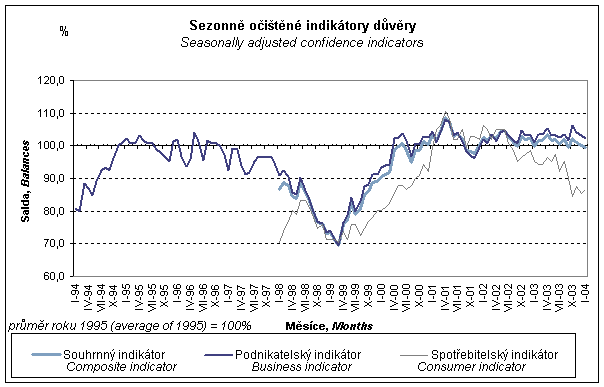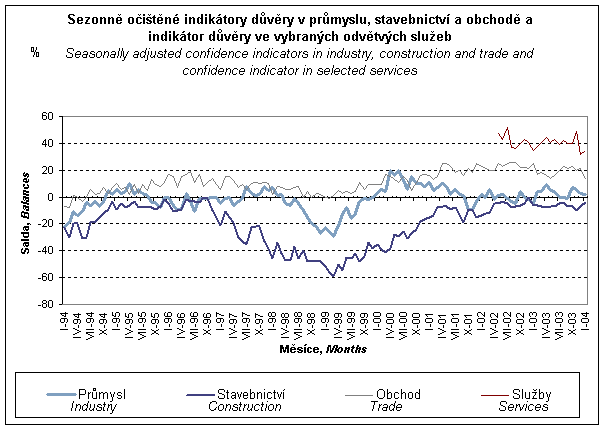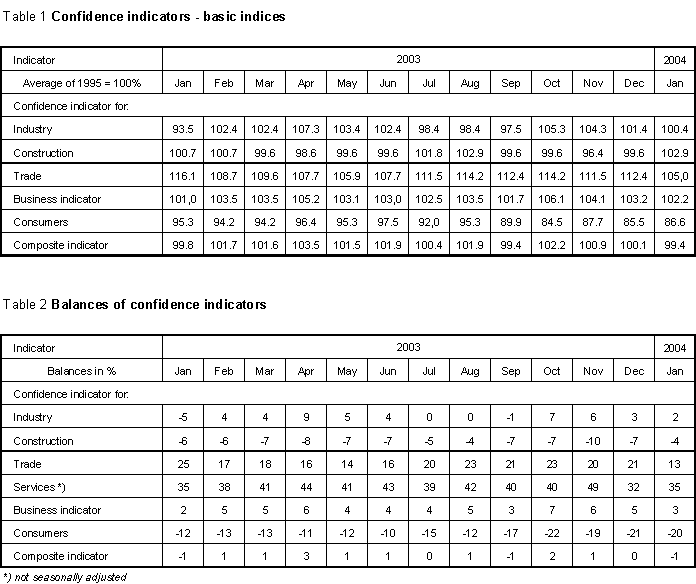Business cycle survey - January 2004
Contradictory development of confidence indicators
Publication Date: 28. 01. 2004
Product Code: r-1201-04
In January 2004 the composite confidence indicator balance slightly decreased compared to the previous month, namely to the same level as in January 2003. This decrease was caused primarily by a marked decrease of confidence indicator in trade and a long-term lower level of the consumer indicator. Confidence indicator in construction positively influenced the value of the composite indicator.

In industry (943) 38% of respondents considered their economic situation in January good, 59% satisfactory and 3% bad, which is almost the same result as in December. After seasonal adjustment, the assessment of current total demand (order books) for enterprise output did not change compared to December, while the assessment of current foreign demand (order books) for enterprise output decreased (balance 5 pts. down). Finished goods stocks decreased (balance 4 pts. down), the respondents say.
The respondents expect a slight decrease in employment in next three months (balance 1 pt. down). At the anticipated slowdown of production activity in the beginning of the year, they expect a decrease in their total economic situation in next six months to come (balance 3 pts. down). (All the data seasonally adjusted.)
On the whole, the confidence indicator in industry decreased slightly on the previous month. Compared y-o-y, it is 7 points up on January 2003. The production capacity utilisation remained almost unchanged compared to October (0.2 pt. down) and reached 85%.
In construction enterprises (448) the markedly good assessment of the current economic situation from previous months prevailed in January (after seasonal adjustment). In January it increased even more (balance 16 pts. up). After seasonal adjustment, the assessment of domestic demand (order books) for enterprise output increased (balance 5 pts. up), while that of foreign demand (order books) for enterprise output, which is still low, increased too (balance 14 pts. up). The respondents expect improvement of employment in next three months (balance 2 pts. up). The overall confidence indicator in construction increased compared to the previous month.
Of respondents engaged in trade (311) 37% considered in January the economic situation of their enterprises good, 60% corresponding to the season and 3% bad, which is a worse result than in December (balance 7 pts. down, seasonally adjusted). They signal a rise in the amount of stocks (balance 4 pts. up). 67% of respondents anticipate no changes in the economic situation in next six months to come (56% in December), 24% predict improvement (38% in December) and the remaining 9% expect worsening (6% in December). The overall confidence indicator in trade decreased.
In selected services (726) 66% of the respondents assessed their economic situation in January to be good (55% in December), 33% of them saw the situation adequate to the season (44% in December) and 1% saw it bad (the same as in December). 23% of the respondents expected a rise in demand for enterprise output (order books), and 56% or 21% of respondents anticipated an unchanged or worse situation, respectively. This is a much worse expectation than in the previous months. No changes in prices should occur according to 71% of respondents, 28% envisage a rise and 1% a decrease in prices. A decrease in the number of employees is expected by 39% of respondents, no changes are expected by 48% of them, and 13% of respondents expect an increase. The overall confidence indicator in selected services slightly increased.

A survey taken in consumers (1000) in January suggests an improvement of the balance of assessment of the total economic situation and their financial situation in next twelve months . The expected total economic situation balance increased by 2 points and the balance of expected consumers’ financial situation rose by 1 point. The share of consumers expecting an increase of unemployment increased compared to December, and the balance increased by 3 points. The share of consumers intending to save money increased (balance 4 pts. up). The overall consumer confidence indicator increased.

Methodological notes:
Contact: Marie Hörmannová, phone (+420) 241019120,
e-mail hormannova@gw.czso.cz
Source: CZSO business surveys, GfK Praha consumer survey
End of data collection: 22 January 2004
End of data processing: 26 January 2004
For more information see: https://csu.gov.cz
Methodological explanatory notes :
The composite confidence indicator is a weighted average of seasonally adjusted confidence indicators in industry, construction, trade, and of the consumer confidence indicator. The composite business confidence indicator is a weighted average of seasonally adjusted confidence indicators in industry, construction and trade. The confidence indicator in industry has a double weight. Since January 2002, the consumer confidence indicator has been composed of four indicators (expected financial situation of consumers, expected total economic situation, expected total unemployment (with inverted sign) and savings expected in 12 months to come). Since January 2003, the confidence indicators have been presented as basic indices; the base being the average of 1995.
The branch confidence indicators are constructed as averages of seasonally adjusted weighted business cycle balances. The business cycle balance is the percentage difference between the responses “growth (+)” and “fall (-)”. The confidence indicator for industry is the average of seasonally adjusted balances of three indicators (the assessment of total demand, stocks of final production (with inverted sign) and the expected development of production activity). The confidence indicator for construction is the average of two indicators (the assessment of total demand and the expected development of employment). The confidence indicator for trade is the average of three indicators (the assessment of economic situation, stocks (with inverted sign) and the expected development of economic situation). The business cycle survey in selected services has been conducted by the Czech Statistical Office since May 2002. This is why the time series are not seasonally adjusted. Data for hotels and restaurants are included in the data for selected services. The time series are converted and the data are comparable. The confidence indicator for selected services is the average of three indicators (the assessment of economic situation, the assessment of demand and expected demand). The confidence indicator for selected services is not being included into composite indicators, yet.
The data above were derived in a weighted manner: sales were used as weights for industry, services and trade, whereas construction work of contractors and subcontractors was the weight for construction. The responding groups of enterprises account for more than a half of sales (industry) and volume (construction) and for a quarter of sales in trade.
